Honor Award
Grid/Street/Place: Essential Elements of Sustainable Urban Districts
RTKL Associates Inc., Los Angeles USA
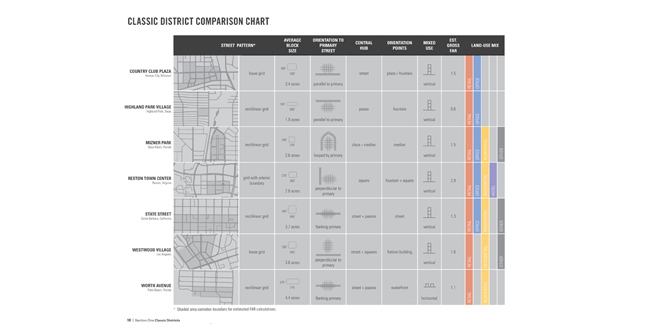 Close Me!
Close Me!Section One of GSP examines over a dozen "Classic District," many of which were built during the first decades of the 20th century. A graphic table compares and analyzes these districts based on such variables as street pattern, block size, floor area ratio, mixture of use, etc.
Download Hi-Res ImagePhoto 1 of 15
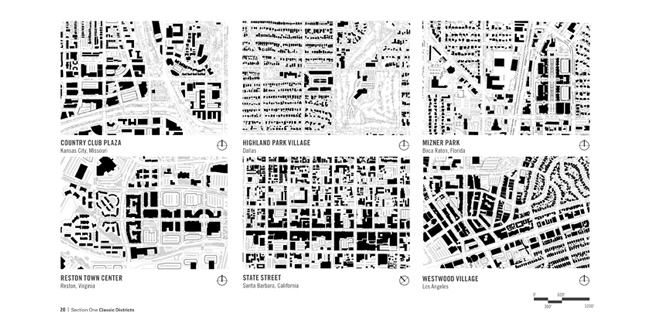 Close Me!
Close Me!Figure-ground illustrations drawn to the same scale assist in the comparison between classic districts.
Download Hi-Res ImagePhoto 2 of 15
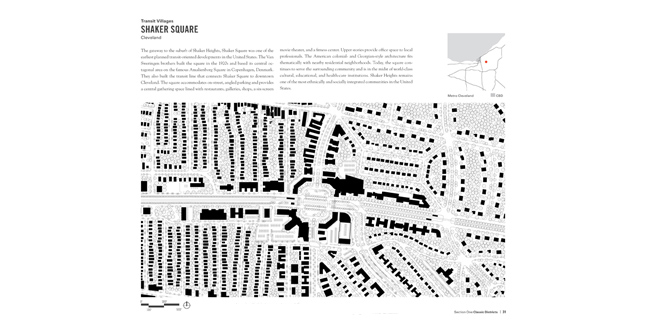 Close Me!
Close Me!For each classic district an enlarged figure-ground illustration allows more detailed investigation, supplemented by a brief description of the place. The selected page shows Shaker Heights in Cleveland as an exemplar of an historic transit village.
Download Hi-Res ImagePhoto 3 of 15
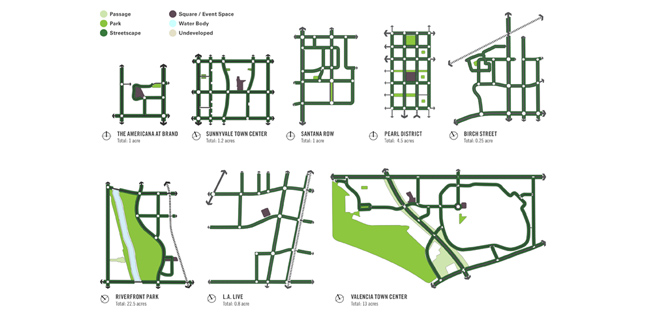 Close Me!
Close Me!Section Two of Grid/Street/Place provides a multifaceted look at 15 “Mixed-use Districts” of more recent origin. Comparative mapping examines figure-ground relationships, circulation pattern and block size, land use mix, and as depicted on this page open space networks.
Download Hi-Res ImagePhoto 4 of 15
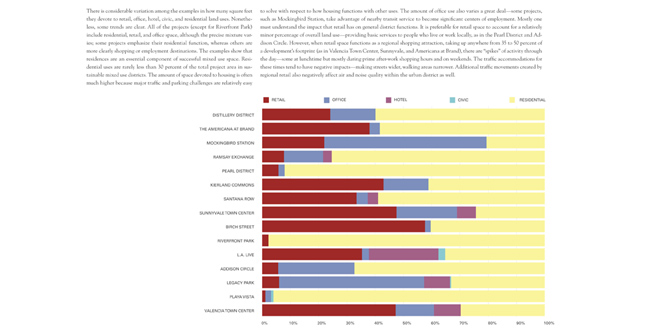 Close Me!
Close Me!A series of graphs offers supplementary means of comparing mixed-use districts, drawing conclusions from such variables as project land area, land coverage by acreage, project intensity (FAR), gross dwelling density (DU / Acre) and as depicted on this page land use by percentage.
Download Hi-Res ImagePhoto 5 of 15
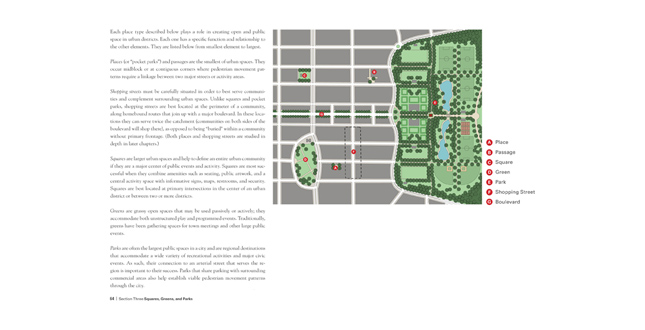 Close Me!
Close Me!Section Three of Grid/Street/Place looks at “Squares, Greens, and Parks.” To aid comparison a distinction between each place type is established and explained based on their role in an urban district.
Download Hi-Res ImagePhoto 6 of 15
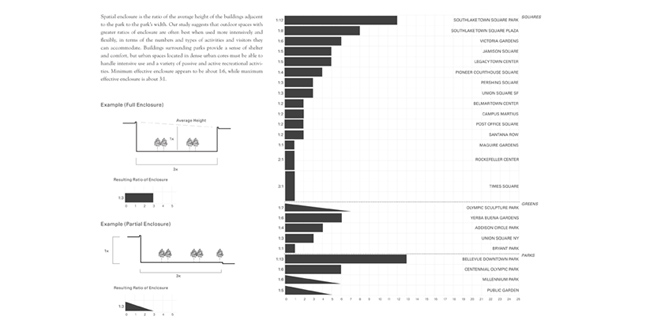 Close Me!
Close Me!Spatial enclosure is an important characteristic of public outdoor space. This page explains and measures spatial enclosure for each of the squares, greens, and parks studied by GSP.
Download Hi-Res ImagePhoto 7 of 15
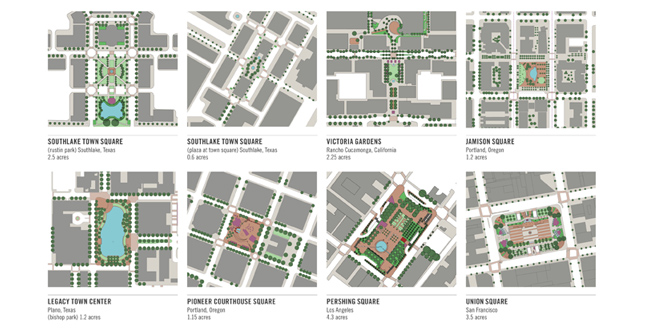 Close Me!
Close Me!GSP offers a scale comparison of two dozen well-known public outdoor spaces. This page shows a selection of the colorful plan diagrams used to illustrate the scale comparison.
Download Hi-Res ImagePhoto 8 of 15
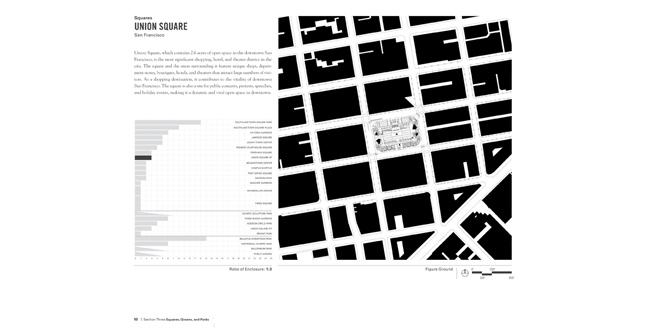 Close Me!
Close Me!A two-page spread provides additional context and analysis through figure-ground and plan diagrams, a section drawing, and some basic facts and figures for each public outdoor space studied. This is the first of a two-page spread presenting Union Square in San Francisco.
Download Hi-Res ImagePhoto 9 of 15
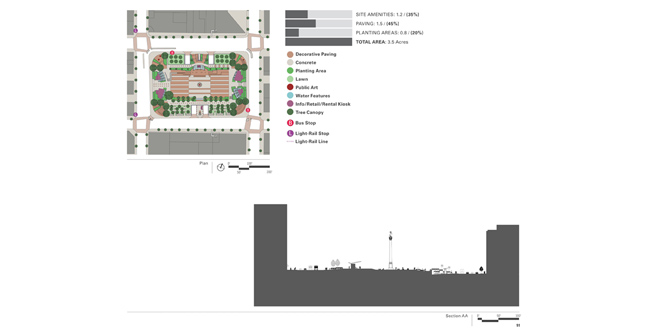 Close Me!
Close Me!This is the second of a two-page spread depicting Union Square in San Francisco, including a plan diagram analyzing its layout and component parts, as well as a sectional drawing to visually explain its visual enclosure.
Download Hi-Res ImagePhoto 10 of 15
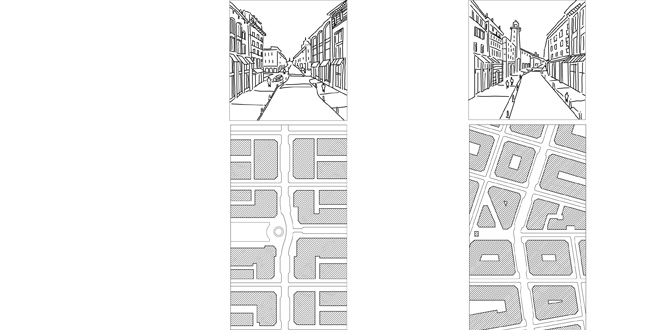 Close Me!
Close Me!Sections 4 and 5 of GSP analyze "Shopping Streets" and "Places." Text and diagrams classify and provide scale comparisons; this is one of two pages describing the potential configuration of shopping streets.
Download Hi-Res ImagePhoto 11 of 15
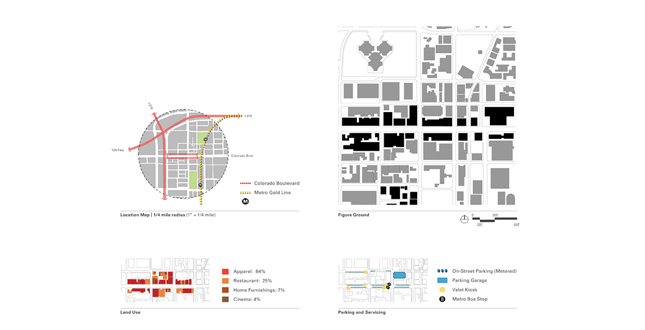 Close Me!
Close Me!A four-page spread offers detailed analysis of each shopping street and place explored by Grid/Street/Place. The following four-page spread looks at Colorado Blvd. in Pasadena, CA, with the first page providing context through a location map and a figure-ground drawing of the surroundings.
Download Hi-Res ImagePhoto 12 of 15
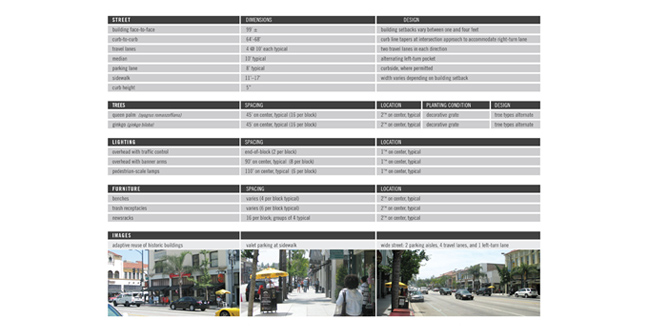 Close Me!
Close Me!The second page analyzing Colorado Blvd. is a table presenting key measurements and other factual data drawn from on-site investigation. Included are building face-to-face, travel lane and sidewalk measurements, as well as the identification and spacing of street trees, lighting, and furniture.
Download Hi-Res ImagePhoto 13 of 15
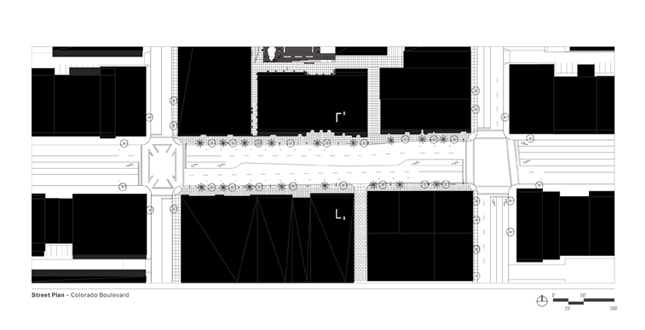 Close Me!
Close Me!The third page analyzing Colorado Blvd. shows the plan of a typical block.
Download Hi-Res ImagePhoto 14 of 15
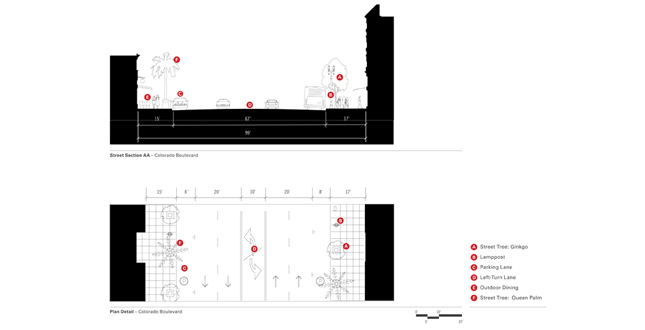 Close Me!
Close Me!The fourth page looking at Colorado Blvd. shows a section drawing and plan enlargement with measurements.
Download Hi-Res ImagePhoto 15 of 15
Project Statement
Grid/Street/Place: Essential Elements of Sustainable Urban Districts was written by our group of multidisciplinary practitioners (landscape architects, architects, planners) who see research as integral to our work. We set out to more fully understand the elements that make places successful, and began with walking, measuring, and drawing some of the most popular gathering spots in and around our hometown of Los Angeles. In time, we expanded our study to include noteworthy built environments from across North America. Eventually, we came to see the value in sharing our findings, with the results published by APA Planners Press in October 2009.
Project Narrative
—2010 Professional Awards Jury
Purpose
How can we evaluate growth and change in the urban environment? How can we use these evaluations to create a more intelligently conceived, more sustainable, and more livable city of the future? These are especially pertinent questions in light of current discourse on smart growth. Working toward answering these questions, the book examines different scales and aspects of urbanism throughout North America, grouped under five chapters as follows: 1) classic districts; 2) mixed-use districts; 3) squares, green, and parks; 4) shopping streets; and 5) places. Numerous maps, diagrams, and charts allow us to assess differences and commonalities. Based on our research, findings are presented that we believe are the essential elements of sustainable urbanism.
Audience
We describe Grid/Street/Place as our "playbook." It compiles the information we now use to begin a conversation with a client and stakeholders about what a project could or should be. By gathering a range of notable projects and analyzing them in a variety of ways, we begin to understand what makes them functionally and aesthetically successful, why they are so memorable, and perhaps most important, why many have withstood the test of time. By sharing this reference material, we are looking to provide an invaluable resource for practitioners, developers, policy makers, students and others with the vested interest in the design, development and well-being of our communities. We also hope this book sparks discussion about its conclusions and encourages further conversation about the critical ingredients of sustainable urbanism.
Message
We believe that the projects explored in Grid/Street/Place reinforce the significance of community building as a core objective of development. Additionally, they present a broader vision of sustainability—one that goes beyond green roofs and recycled materials to look at how successful places adapt and evolve over time. The examples in the book are generally the ones most often referenced by planners and designers in our North American focused practice. They are valuable for detailed study because they are so well known by the industry, being perceived as readily reproducible market-driven examples. They are a reflection of contemporary practice as much as they are a reflection of successful planning and design.
Impact and Effectiveness
Grid/Street/Place is a unique approach to understanding urban design through empirical research. It examines more than 100 successful projects throughout North America to identify differences and commonalities, and as a result, proposes universal elements that characterize sustainable urban districts. We believe that it will become a standard reference book for planners and designers. Prof. Emily Talen described the merits of the book in this way, "Here are the DNA sequences of successful urban places."
Distribution Method & Circulation
Grid/Street/Place: Essential Elements of Sustainable Urban Districts was published by APA Planners Press in October 2009. The initial print run included 2,500 copies and was made available through APA's online bookstore, as well as Amazon.com.
Project Resources
Author
Nathan Cherry
with Kurt Nagle, ASLA
Publisher
American Planning Association Planners Press
Contributors
Alice Ockleshaw, Alyce Sparkman, Cody Clark, Crissy Zhou, Dave Kermode, Jenny Zhou, Johan Roa, Katie Sprague, Kelly Farrell, Nasim Yalpani, Nick Gotthardt, Orlando Sanabria, Ricardo Cervantes, Rocio Vidal, Seetha Raghupathy, Steve Knudsen, Thom McKay, Victoria Mendez






